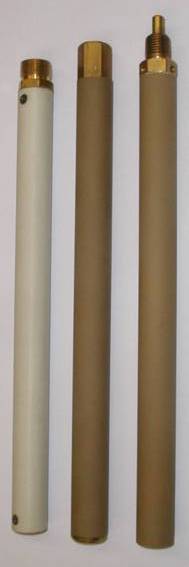 Impeders shown above, left to right, are as follows:
| EHE’s return flow impeders enable most types of tubing to be produced with a completely dry I.D., using high frequency induction welding equipment. There are many applications where a dry & clean I.D. is required to prevent corrosion, permit tube I.D. painting or powder coating, or simply to reduce the enviromental problems which can occur when mill coolant is left in the tube.
The M-3 & M-4 impeders are a third generation design which offers improvements in performance, working life & serviceability, compared to earlier types. These impeders use standard pipe threads (NPT or BSP) and all seals use silicone rubber o-rings, rather than adhesives which can dry out or crack. No fasteners penetrate the outer casing of these impeders, so the potential for leaks is greatly reduced. The elimination of fasteners also makes these impeders very easy to repair, since the end caps can be easily removed to facilitate replacement of the ferrite or outer cover. M-2 impeders are an older design that are not recommended except for replacement use with existing impeder support systems.
Because return flow impeders usually offer more hydraulic resistance than through flow types, a higher coolant pressure is recommended. A pressure of 4 bar (60 PSI) will ensure adequate cooling under most operating conditions. Coolant flow requirements vary widely due to inlet temperature, weld power, frequency & weld area geometry. A 100 micron or smaller coolant filter is recommended when using return flow impeders.
Since coolant flow can be reduced at lower inlet temperatures, it is beneficial to keep the inlet temperature as low as possible. This may require the use of a heat exchanger or small refrigerative cooler when using return flow impeders. Coolant temperature entering the impeder should not exceed 25 °C (75°F). Higher temperatures will result in lower welding efficiency and reduced impeder life. |
